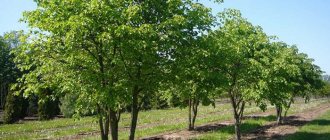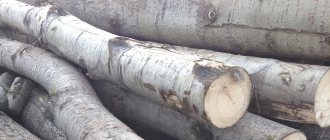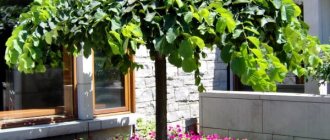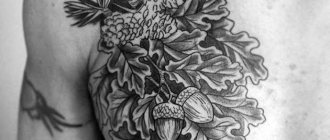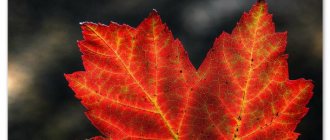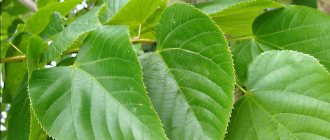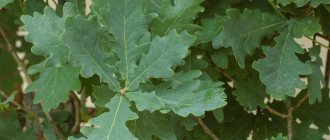The beech is a tall, powerful tree, the thick trunk of which is decorated with sweeping long branches. Under favorable conditions, it can live for several hundred years. This tree is a representative of the Beech family. The spectacular beech amazes with its power, and its thick, wide crown provides cool shade and can save even from heavy rain. This plant also produces valuable wood, which is used for making floors, furniture, etc. With all this, it is quite possible to grow beech in your own local area, the main thing is to follow certain rules.
Features of beech
Beech (Fagus) is a deciduous tree. Even in ancient times, this powerful plant was considered a place where energy and strength were concentrated.
What does a beech tree look like?
This tree has an average growth rate. Its height can reach up to 35–40 m, while its diameter can reach up to 200 cm. Until the beech is a hundred years old, its intensive upward growth is noted. But after this, its active growth in width begins. The crown shape is tent-shaped. The lower branches growing in its depths die over time due to lack of sunlight, and new ones grow in their place. The branches are quite long and thin. Often this plant develops a root claw, and most often it can be seen in adult specimens.
Young beeches are covered with dark brown-gray bark. At the same time, the bark of adult and old plants is a lighter gray shade.
Beech tree.
Foliage and buds
The foliage is placed in two rows. In summer it is greenish, in autumn it is yellow, and in late autumn and in the winter months it is brown. It has an ellipsoidal shape, with a point at the top. The leaf blades are quite large, their average length is from 5 to 10 centimeters.
The tree has fruits, which are small nuts covered with a brown shell. There are seeds inside them. They mature in the last summer or first autumn weeks, after which they quickly fly around (around October–November). In a lean year, approximately 8 kilograms of fruit can be removed from one tree. At the same time, it bears fruit abundantly, as a rule, once every 10 years. The beech bears fruit for the first time only after it turns 40 years old.
Root system
This plant has a well-developed root system. It is highly branched and has several large “anchors” that actively grow and penetrate into the deep layers of the soil. The root system of mature beech trees may protrude slightly. Often, the roots of nearby plants intertwine with each other, and eventually they grow together. Beech differs from other trees in that it does not have a central core.
Features of proper cultivation
When planting beech, you need to understand that the crop is long-lived and does not require replanting, but every year its need for additional space increases. Regarding weather conditions, for active growth and development, a beech tree does not need protection from the sun or, conversely, from the shade, but the beech tree should be protected from the wind.
In the south, in hot weather, the plant will have a hard time, so it is advisable to organize frequent watering of both the tree itself and its crown.
Beech can grow on any type of soil, but it would be ideal if the crop is planted in a place where there is the highest humidity, as well as excellent and fertile soil. The plant does not like high concentrations of salts, so it is better to choose a loamy soil type.
How to properly care
The tree does not tolerate changes in temperature conditions very comfortably; it has poor resistance to cold, even down to 5 degrees below zero. In the north, it is not recommended to plant seedlings of this plant in the open air.
The height of a growing tree is simply enormous, so it will be impossible to cover it with something for the winter; therefore, beech trees should not be planted in such a climate.
Growing a crop outdoors involves organizing frequent watering to saturate it with moisture. It is necessary to mulch the soil to rid the tree of weeds. In addition, it is important to feed the beech at the beginning of spring and at the end of autumn.
Types of beech with photos
In natural conditions, there are approximately 10 different types of beech. At the same time, the following types are most common in culture:
Japanese beech (Fagus japonica)
It is most widespread in the East. It has a relatively compact crown, while its maximum height is about 20 m. The branched trunk is decorated with foliage of classic color and shape.
European beech (Fagus sylvatica)
This species has become widespread in the West and Europe. It has a standard appearance: approximately 40 m tall, dark or light green foliage with a jagged edge.
Eastern beech (Fagus orientalis)
In nature, it can be seen on the Black Sea coast and the Caucasus. This tall (about 40 m) tree is decorated with elongated foliage.
Large-leaved beech (Fagus grandifolia)
Its elongated foliage has a more rounded shape. The species is most widespread in North America.
Features of the chemical composition
Oriental beech nut kernels contain:
- up to 48% proteins;
- starch and sugar (3 - 5%);
- tocopherol;
- organic acids and fatty oil (50 - 57%);
- tannins;
- nitrogenous substances (up to 30%);
- citric and malic acids.
In addition, they contain the poisonous alkaloid fagin, which decomposes when the nuts are roasted. As a result, they become harmless to humans. About 5% of creosote contains tar from beech wood. This substance is a mixture of different phenols. The bark contains vanilloside and citric acid. The wood contains cyclopentanol and ethyl guaiacol.
Where does the beech tree grow?
Some experts claim that beech appeared on Earth before our era, and it grew in the territory from the Urals through Kamchatka, Greenland, Alaska and Canada. Later, such a tree began to grow in southern Eurasia and North America.
The Ice Age caused a significant reduction in the number of beech trees, and its place was taken by more frost-resistant coniferous trees. It is because of this that today most of the continental territories are covered with other tree species, and not beech.
Nowadays, beech is found in various parts of the world, for example: in Europe, America, Russia, etc. It grows best on nutritious soil, and is most often found at an altitude of 1.5–2.5 thousand meters above sea level.
Oriental beech: history and features of the name
Since ancient times, Eastern beech has been grown in Europe as a very valuable sacred plant.
In the mythology of many European countries, the beech tree acts as a protector and patron of the family, and is also a symbol of masculinity and perseverance. In addition, this tree was considered a kind of keeper of ancient knowledge and wisdom, so it is not at all surprising that its scientific name is translated from German as “book”. The rather high sacred status of the eastern beech is also evidenced by the fact that its heavenly patrons were considered exclusively the supreme gods - Zeus, Jupiter, Perun and Odin.
Planting beech in open ground
Despite the fact that beech has a spectacular appearance, many novice gardeners do not dare to decorate their garden with it. Typically, this is because they simply have no idea how to care for it. However, it is not demanding in care and is relatively unpretentious.
The most difficult thing about planting beech is choosing the optimal time. Early spring is best for this. In this case, planting must be completed before the buds open. If you plant a tree later than expected, then its growth will be slower and it will be more susceptible to disease.
This crop can grow on a variety of soils. However, nutritious soil to which fertilizer has been added is best suited for it.
When choosing a place for planting, you should take into account that the long-lived beech grows very tall and has a wide crown. At the same time, the root system of a mature plant is well developed and takes up a lot of space. In order for the beech to develop and grow normally, it is recommended to put a fence around it. The fact is that on trampled ground its growth deteriorates significantly.
The planting hole for planting a seedling should be approximately 0.8x0.8 meters in size. The soil should be well drained. When preparing the hole for planting, it is recommended to fertilize the soil, which will help activate the development and growth of the root system. When the planting of the seedling is completed, it is watered abundantly, and then the trunk circle is mulched with a layer of dried mown grass. Mulch helps slow down the evaporation of moisture from the soil, as beech grows well in high humidity.
In order for a tree to grow rapidly and develop properly, it needs a climate that is not too hot and a large amount of sunlight. If necessary, the crown can be additionally moistened by irrigation.
7sotok.by
The content of the article:
1.Description of beech.
2.Beech varieties.
3.Planting beech.
- Time and place to plant beech.
- The soil.
- Landing technology.
- Fertilizer.
4. Beech care.
- Trimming.
- Watering.
5. Beech diseases and pests.
6. Beech propagation.
The word beech itself was borrowed from the Slavs from the Germans, because in some Germanic languages the word “beech” is translated as “book,” and this is due to the fact that the first runes were written on wooden sticks made from beech.
The height of beech often exceeds 40-50 m, and the trunk diameter can reach more than 2 m. Despite the variety of beech species, all its varieties have a smooth crown, with thin gray bark. Beech leaves are entire, there are small serrations on some varieties of the plant. Most often, the leaf shape resembles an oval, the leaf length is from 7 to 15 cm, and its width ranges from 5 to 10 cm. It blooms simultaneously with the leaves blooming, forming flowers collected in earrings, up to 15 cm long. Beech is pollinated by the wind. Flowering of beech trees growing in groups occurs after 60 years, but for solitary trees, flowering occurs after 40-50 years. The beech fruit is acorn-shaped, collected in 2 or 4 pieces. in a cyst. Covered with a wooden shell, dark brown, up to 15 mm long. Beech nuts are edible but have a bitter taste.
Beech grows very slowly, but its lifespan can reach more than 400 years. Beech has a peculiarity: due to its spreading branches, which are formed mainly closer to the top of the tree, the lower branches do not receive light for photosynthesis, so they die off at an early age. The trunk of the tree remains bare, and spreading branches form at the top of the tree. The tree is very shade-tolerant, but loves the sun and prefers loamy soils. Most often it reproduces by seeds, but it can also produce lateral shoots.
Beech is often used as a green hedge; its long-growing foliage helps to maintain its curly shape for several months. It is also used in the landscape; massive or single plantings of beech are often observed in parks or gardens. Beech is planted on the banks of rivers or reservoirs, the roots of the tree protect the soil from erosion. Beech is very valuable because of its snow-white wood, it is used in the furniture industry, beech parquet is popular, and musical instruments are made. Edible oil is made from beech fruits and is used in the food and confectionery industries. Beech nuts contain many nutritional elements: proteins, sugar, citric and malic acid.
Varieties.
European Beech (Forest).
It is considered the most common variety. Due to its truly gigantic size, this variety is often planted in parks, gardens, or used for landscaping cities. But most often this variety can be found in the forest. European beech exceeds 50 m in height, and the diameter of the trunk of an adult tree can be more than 2.5 m. The bark is gray or light brown. European beech has spreading branches that form a lot of shade, so planting other plants nearby is not recommended. The leaves of beech are oval-shaped, up to 10 cm in size, dark green in color; in autumn the beech changes the color of the leaves to yellow or reddish shades. This variety does not like compacted and acidic soils; it prefers to grow on nutritious and loose soils.
European beech has many ornamental varieties. Among them the following type stands out:
"Atropunicea".
With black and red leaves, which look very impressive against the background of the green foliage of other plants.
"Cuprea".
Another type of beech with leaves of copper tones, with an unusual dissected and pinnate leaf shape.
"Tortuosa".
This variety is distinguished by long and weeping branches.
"Riversii".
It has unusual leaves of purple shades.
Eastern Beech.
A very popular species of the beech family. The height of the tree often exceeds 50 m; spreading branches form a lot of shade. Prefers to grow on moist soils, is shade-tolerant and very thermophilic. The crown of the eastern beech is thin, the trunk is gray, but the wood is snow-white, slightly yellowish, and resistant to rot. It differs from others in having more elongated leaves. Young leaves are light green in spring, and change color to yellowish-red in autumn. Oriental beech is usually propagated by seeds, cuttings or shoots. The seeds have a high germination rate, but for the first 3 years, the seedlings grow slowly, and then their growth accelerates.
Beech Jagged.
Belongs to the lesser-known beech varieties. Japan is considered the birthplace of this species. A tree, no more than 30 m high, with long and spreading branches. The trunk of the tree is round in shape, gray in color, with a diameter of 1.5 m. The leaves of the jagged beech are shaped like the leaves of a laurel tree, small, 7 cm long, dense, dark green in color. They retain their green tint until late autumn. Like other beech varieties, the jagged variety prefers to grow in sunny locations, but also grows well in the shade. Loves moisture and nutritious soils. It tolerates severe frosts well and is resistant to diseases and pests.
Large Leaf Beech.
It differs from other varieties in its unusual leaf shape. On long branches, many round leaves are formed, dark green in color with white veins. This shape of the leaves gives the beech a lush appearance and allows it to form a rounded shape. The tree itself is small in height, after 10 years the tree will grow no more than 12 m, the crown is light brown. This species does not tolerate the shade of taller plants, prefers sunny places, and loves moist soils. Will withstand cold and frost.
Large-leaved beech.
This beech variety is primarily native to the United States. The tree reaches a height of 35-40 m. The trunk is straight, the bark is smooth, bluish-gray in color. The leaves are oval in shape, green in shades with pointed ends and a transverse pattern. This beech variety is most often found in mixed forests and tolerates shade and drought well. Seedlings can be obtained from seeds, their germination rate is quite high, but caring for young trees in the first years will require attention. Young beech of this species needs shelter for the winter, careful watering and nutritious soil.
Landing.
Time and place to plant beech:
Beech is an unpretentious tree that takes root well in any soil. But when planting young seedlings, it is still necessary to choose the right time for planting. In spring, young trees will take root well in a new location if they are provided with thorough watering. It is also important to plant seedlings before buds bloom on the trees. Otherwise, the beech will slow down its growth and become sick.
A month before the onset of cold weather (October - early November), seedlings can be planted in the ground. In the fall, the tree will need a lot of moisture to survive the first winter. Mature trees are not afraid of the cold, beech is frost-resistant, but young trees are better covered with film or covered with a thick layer of grass. This will help the tree not only retain heat and moisture in the ground, but also save the plant from rodents. The place for planting beech should be chosen based on the fact that beech is long-lived; with proper care, the tree can live up to half a century. In addition, the older the tree, the more branches there are, forming abundant shade, under which smaller plants cannot grow.
The soil:
Beech grows well in all soils, but does not tolerate oxidized and trampled soils. The soil for planting should be prepared almost six months before planting. This is due to the fact that the root system of the tree develops quickly. The roots will need plenty of room to develop and well-prepared soil. Therefore, in order to plant beech seedlings in the spring, at the end of autumn you need to choose a place, dig a hole and fill it with water. In a few months the ground will settle, and frost will serve as a preventative against pests.
Planting technology:
The technique for planting beech trees is simple. For beech, it is better to dig a larger hole, 80x80 cm, for faster root development. You can put some crushed stone or small broken bricks at the bottom of the hole. Next, the soil is prepared from soil, peat and mineral fertilizers, everything is thoroughly mixed. Young seedlings are placed in a hole and covered with the prepared mixture. The tree must be filled with warm water and the ground covered with dry grass to retain moisture.
Fertilizer:
Beech needs fertilizers and fertilizing only when it is young. Fertilizing in the spring can consist of a solution of mullein or manure, mineral and potash fertilizers. But in the fall, the best feeding will be simply digging up the earth around the tree trunk. This will allow the roots to breathe and protect them from harmful insects.
Care.
Trimming:
Beech produces abundant foliage, and the older the tree, the better the branches and leaves grow. In addition, due to the slow growth of foliage and tree crown, beech is used to create hedges. Able to maintain its given shape for a long time. Once a year, preferably in the spring, young trees undergo sanitary pruning. Branches frozen after winter are pruned. Branches that provide shade to the lower shoots are also removed. Branches that are infested with pests or broken are cut out. In adulthood, beech does not need pruning.
Watering:
Thanks to its gigantic size and developed root system, you might think that beech is able to get its own water, but this only applies to mature trees. Young seedlings need watering at least once a week. Beech also loves “sprinkling”, sprinkling with water, this helps get rid of dust on the leaves and “wash away” many pests. Beech is also demanding when it comes to loosening. After watering, a few days later, the soil around the tree must be loosened to give the roots air. Next, you can cover the ground with spruce branches or grass to retain moisture.
Diseases and Pests.
The beech tree suffers most from the silkworm butterfly and caterpillars. These insects eat young beech leaves, thereby exposing the branches, making the tree weaker and more susceptible to disease. The caterpillars are mostly green in color, so it is extremely difficult to notice them against the background of foliage. The pest can be detected by irregularly shaped leaves, which subsequently turn yellow and fall off.
Secretive stem pests are also capable of harming beech trees. These pests “settle” in the trunks of mature trees, feed on its sap and lay larvae. These include the granular longhorned beetle; this beetle harms the tree by eating its leaves, buds and flowers.
Aphids and mites also often attack beech trees and live on branches and leaves in entire colonies. These pests also “feast” on young leaves, buds and even thin branches. If these insects are not detected in time, the beech bark may crack, which will lead to the tree becoming infected with beech canker fungus.
Beech is also infected with powdery mildew, which covers the leaves with small white cobwebs, causing the leaves to fall off in the second half of summer. Caps of various mushrooms may also form on the tree, which indicates rot in the tree bark or wilting of the entire plant.
The most proven way to eliminate these diseases is to timely spray the tree with various chemicals, solutions of ash, grated soap, infusions of dandelions and garlic.
Reproduction.
Beech propagates in several ways: by cuttings, grafting or layering - these 3 methods are extremely uncommon, because the survival rate is very low, it takes a lot of time and effort; most often these breeding methods are used by experienced breeders. But even a novice gardener can propagate beech using seeds.
First you need to collect quality seeds for planting. Beech seeds resemble sunflower seeds in shape, are collected in early or mid-autumn, the ripe fruits fall to the ground, so the germination rate of these seeds will be much higher. The seeds should also be dry and brown in color. In winter, seeds must be stored in a cold place, first hidden in a box and wrapped in cloth - this reminds the seeds of the natural storage conditions in winter, in the cold and on the ground. Closer to spring (early March), they need to be taken out and warmed up in a warm place for several days. To neutralize seeds from diseases, you can place them for a day in a weak solution of potassium permanganate.
The seeds are first planted in small containers, previously prepared in loose and moist soil. To help them germinate faster, use a sharp knife to carefully open the bark without damaging its core. It is better to plant the seeds one at a time, because... The beech germinates quickly and begins to actively grow within a month after planting. The seed is placed in a container and covered with soil, after which it is watered generously with warm water. To create a “greenhouse” effect, you can cover the container with a plastic bag, remembering to periodically open it to ventilate the soil. In just a couple of weeks, if planted correctly, young shoots will appear, which require frequent watering, sun and high indoor humidity.
Often beech is planted using green shoots. In place of the old felled tree, on its stump, the beech quickly produces young shoots. Such a shoot can be carefully cut with a knife, and small indentations can be cut at the end of the seedling (this is where new tree roots will grow). The seedling must be immediately placed in water. To prevent the water from stagnating, it must be changed periodically, removing the mucus that has formed from the beech roots and rinsing it with water. In a couple of weeks, roots will begin to sprout on the young beech tree. After they grow and become stronger, the tree can be planted in a permanent place. It is worth saying that young beech trees do not like replanting, the roots weaken and the tree slows down its growth. Therefore, you should worry about choosing a place in advance.
Beech care
After the beech is planted in open ground, special attention should be paid to fertilizing, watering and pruning.
Watering
In order for the beech to grow healthy and its development to take place within normal limits, it should be provided with timely and proper watering. While the tree is young, it is watered and sprayed once every 7 days. If the climate in the region is hot, then you can water the plant every day. However, you should not expect that in such a climate the development of beech will take place within normal limits. If the climate is favorable, then adult plants may not be watered at all.
Top dressing
Most gardeners believe that such a tree needs to be fed only while it is young. This statement is quite correct. However, annual feeding helps stimulate plant growth and helps prevent infection with various diseases. Fertilizers are applied to the soil at the beginning of spring or in late autumn.
Trimming
While the beech is young, even an inexperienced gardener can cope with pruning it. Moreover, if desired, it can be given any shape. And since an adult tree is quite tall and has a wide crown, not everyone can prune it. Formative pruning is recommended to be done in early spring. At the same time, you need to cut off all old, dried, injured and diseased branches.
Use on the farm
Eastern beech wood has unique properties. However, it is not very resistant to rotting. In terms of durability and strength, it is significantly inferior to chestnut, oak, and coniferous wood, so it is used less often in construction. It is mainly used in furniture production (previously bent Viennese furniture was made from it), in the manufacture of barrel staves and for the production of parquet. In addition, sleepers are made from it after preliminary impregnation with special compounds, and roofing shingles.
Due to the plasticity of wood, musical instruments are made from it. Beech is a highly sought-after material for making knife handles and weapon butts. Beech is a medium-density species with high breathability. Its wood easily absorbs moisture and therefore requires special storage and processing conditions.
Beech nuts are used to make flour from which special flatbreads are baked. It is made from carefully peeled and well-roasted nuts. By adding a little wheat flour to it, you can get an excellent mixture for baking pancakes, pancakes, and crumbly cookies.
Beech nuts are a valuable nutritious food for animals that live in the Caucasian forests, for example, wild boars. In addition, buried by animals in the ground, they give rise to young shoots of the beech forest. Beech branches are used as feed for domestic goats and sheep.
High-quality edible oil is made from the nuts. It is colored light yellow and is not inferior in taste and nutritional value to olive oil. In baking, they often replace almond and nut butter. In addition, it is seasoned on salads, added to second and first courses, as well as to confectionery products. The cake remaining after pressing the oil is used to make coffee surrogate. Interestingly, beech is considered one of the sweetest trees. By breaking off a piece of bark, you can collect healthy, sweet and very pleasant-tasting beech juice.
| Eastern beech | |
| General view of an adult tree | |
| Scientific classification |
| Domain: | Eukaryotes |
| Kingdom: | Plants |
| Sub-kingdom: | Green plants |
| Department: | Flowering |
| Class: | Dicotyledons [1] |
| Superorder: | Rosanae |
| Order: | Beech-flowered |
| Family: | Beech |
| Subfamily: | Beech |
| View: | Eastern beech |
| International scientific name | |
| Fagus orientalis Lipsky (1898)
Eastern beech [2] (lat. Fāgus orientālis) is a species of flowering plants of the genus Beech ( |
Reproduction methods
You can propagate beech yourself using seeds, cuttings, layering and grafting. The generative method of propagation (seed) is most often used, as it is more efficient. For sowing, fully ripened seed material is used.
The collected seeds are soaked for some time in a solution of potassium manganese. Once the weather is warm outside, you can sow them in the soil.
Growing beech seedlings
There are several main methods of propagation; everyone will decide for themselves how to grow a beech tree. The most common are:
- generative method
- grafting method
- using cuttings
- offshoot cultivation
For a beginning gardener, the most accessible and effective method is the generative (seed) method. Harvesting begins in mid-October, when the ripe fruits fall from the tree. During the winter, seed material must be stored in a cool, dry place, for example in a cellar.
8-10 days before planting, it needs to be taken out of the cellar and warmed up for several days. The collected seeds are kept for some time in a solution of potassium permanganate.
After sowing the seed, the planting site should be covered with thick cellophane for some time; this will keep the soil moist for the time necessary for the seeds to hatch. Young shoots of the future tree will appear in a few days.
Diseases and pests
Beech is not highly resistant to diseases and pests. At the same time, it is most susceptible to fungal diseases. In addition, such a tree often develops trunk cancer.
The greatest danger to beech is posed by pests such as pine beetles, lacewings, bark beetles, caterpillars, shuttle moths and others.
In order to prevent diseases and pests, beech trees need to be inspected regularly. Cut out all affected areas in a timely manner and begin treatment immediately after the first signs of a fungal disease appear.
Botanical description [edit | edit code ]
Representatives of the species are trees up to 50 m high, with a powerful and dense ovoid or wide-cylindrical crown, rounded at the top. The trunk is columnar, covered with light gray smooth thin bark. Young shoots are initially drooping and pubescent; then bare, geniculate, brownish, rising as they become lignified.
Buds are up to 2 cm long, fusiform, with light brown scales. Leaves are alternate, wavy, entire, sometimes ciliated or sparsely toothed, elliptical (maximum width above the middle), 7–11 (5–20) cm long and 2.5–8 (up to 11) cm wide, with a wedge-shaped base and gradually pointed at the apex, naked above, dark green, shiny, pubescent along the veins below. Petioles are pubescent, 0.5-2 cm long. Stipules are reddish, falling off early. In autumn, the leaves turn pale and then brownish-yellow and fall off.
The flowers are small, inconspicuous, in complex inflorescences composed of dichasia, unisexual (rarely bisexual), monoecious. The perianth of the staminate flowers is broadly bell-shaped, about 5 mm long, with five to six broadly oval lobes, covered at the edges with black, less often white, hairs. Staminate flowers are collected in multi-flowered capitate inflorescences hanging on long peduncles from the leaf axils. Stamens up to twelve; sometimes there are rudimentary pistils. Pistillate flowers are collected in twos (four) and are surrounded by a four-lobed involucre (plush), sitting on a short erect peduncle. The outer side bears numerous modified leaves. The perianth is three- or five-lobed, fused with the lower three-lobed ovary; the columns are three in number, turning into long, hairy, thread-like, curved stigmas. It blooms in May - June, at the same time as the leaves bloom. Wind pollinated.
The fruit is a brown, shiny, sharply triangular one- or less often two-seeded brown nut, 1.2–2.2 cm long and 0.5–1 cm wide, somewhat shorter than the lobes of the plus, with a thin woody pericarp. Nuts are two to four in a bunch, which opens into four lobes when the fruit ripens. The nuts ripen at the end of September and fall off in October. Weight of 1000 nuts 285 g [4]; 1 kg 3500 pieces. Harvest years are after three to four years in the lower parts of the mountains and after 9-12 years in the highlands. The nut harvest is 20–1000 kg per hectare [3].
The wood is white with a yellowish tint. Sapwood does not differ in color from mature wood. In overmature trees, a reddish-brown false kernel is often found. Tree rings are clearly visible in all sections.
Application and meaning of beech
The majestic beech tree is very useful. At the same time, its wood is of particular value.
Wood
Beech wood is widely used in industry because it has excellent texture and density. It is very difficult to distinguish beech fibers in cross-section, which is why seamless structures are often created from it.
This wood is used for making furniture, knife handles and other tools, flooring, plywood, wooden toys, etc.
Which wood is stronger? Beech vs Pine
Application in landscape design
Beech looks quite different from those trees that are especially widespread in cultivation. In this regard, it is often used to create unusual decorative compositions. This culture can fill any area with magic and majesty, thanks to its powerful and large roots that protrude outward.
Growing beech on your own plot is not particularly difficult. The main thing is to choose a suitable place for planting and provide the plant with timely watering and fertilizing. This mighty and majestic tree can delight with its unusual beauty for many hundreds of years.
European beech // open ground of the Botanical Garden of St. Petersburg State University
Beech and its valuable wood
At all times, people have used earthly gifts to improve their lives. Trees have always occupied an important place in this matter and beech is no exception. Many useful things were made from it. Among other things, I would like to mention:
- various musical instruments;
- parquet;
- sheet plywood;
- measuring instruments;
- furniture;
- paper.
As you can see, the tree brings many benefits to humans, since its wood has the following properties:
- moisture resistance;
- increased density;
- tendency to form round shapes;
- easy to polish.
It is known that experienced brewers in England, when brewing everyone’s favorite drink, add beech chips to it. This gives it an unusual taste and aroma. In addition, shelving, barrels, and garden gazebos are made from beech. And from the saw cuts you can lay out a path in a country garden.
Application
The substance creosote present in this plant is used as an external remedy, since it has a disinfecting and cauterizing effect. In addition, it is used for inhalation for chronic respiratory diseases, for example, bronchitis.
Creosote has a specific, very unpleasant odor and taste. This substance is irritating to the stomach and also to the kidneys. It is often replaced with guaiacol and other drugs.
The Beech family is also famous for the fatty oil produced from its fruits. It is used in the food industry. At the same time, flour is made from the seeds of the plant, using it for baking. These seeds are also subjected to slight heat treatment in the form of roasting. In this form, they are used to create a coffee drink with excellent dietary characteristics.
Description
Beech is a type of tree that has a smooth, powerful trunk covered with pale gray bark. It has densely leafed branches, a cylindrical dense crown rounded at the top.
The alternate leaves are arranged in two rows. The leaf is elliptical in shape, with feathery veins and solid, slightly wavy edges. Slightly pubescent underneath. The beautiful dark green color of the foliage changes in autumn to bronze or straw yellow.
Flowers are collected in small inflorescences and appear along with the growth of leaves. They can be of different genders. Staminate flowers have an average of 10 stamens. They gather in small capitate inflorescences. Pistillate flowers are collected in groups of 3 and are surrounded by a plus, which grows and becomes woody as the fruits ripen.


